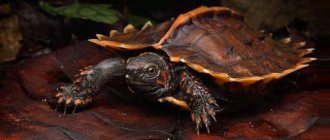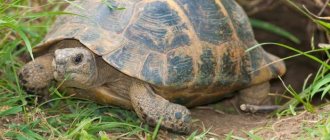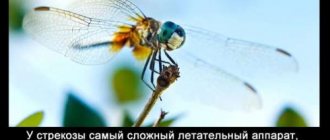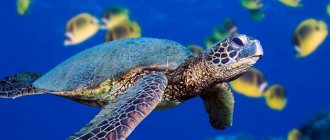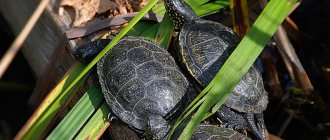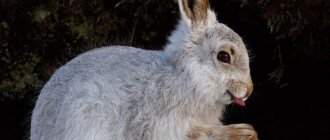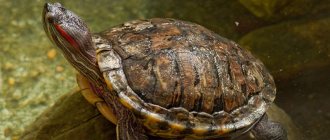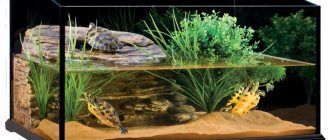- Wild animals
- >>
- Reptiles
The snapping turtle (Macroclemys temminckii) is the only member of the genus Macroclemys. This species is considered the largest freshwater turtle, because the weight of an adult individual can reach 80 kg. These turtles have a rather scary appearance. Their shell is similar to the shell of some ancient lizard. The turtle got its name from the vulture bird due to the fact that they have a similar beak shape with this bird. Vulture turtles are very aggressive, bite strongly and are very dangerous predators.
Origin of the species and description
Photo: Vulture turtle
The snapping turtle belongs to the snapping turtle family. Genus Griffon turtles, species Griffon turtle. The question of the origin of turtles still remains unresolved. Some scientists believe that turtles descended from extinct reptile cotylosaurs that lived in the Permian period of the Paleozoic era, namely from the species Eunotosaurus (Eunosaurs) - these are small animals that look like lizards with wide ribs that form the dorsal shield.
According to another opinion, scientists believe that turtles descended from a small group of reptiles that were descendants of the amphibian discosauriscus. According to recent studies, it has been established that turtles are diapsids with reduced temporal fenestrae and are a related group in relation to archosaurs.
Video: Vulture turtle
The first turtle in history, which is currently known to science, lived on earth about 220 million years ago during the Triassic period of the Mesozoic era. The ancient turtle was very different from modern species of turtles, it had only the lower part of the shell, and there were teeth in the turtle's mouth. The next turtle, Proganochelys quenstedti, which lived in the Triassic period about 210 million years ago, was already more similar to modern turtles, it already had a fully formed shell, however, it had teeth in its mouth. At the moment, a large number of fossil species are known. Among them is the largest turtle of the genus Meiolania, whose shell length was 2.5 meters. Today there are 12 families of turtles and they are being actively studied.
The Macroclemys temminckii alligator snapping turtle is very similar to the snapping turtle, but unlike this species, the snapping turtle has eyes located on the sides. This species also has a more hooked beak and a row of supramarginal scutes, which is located between the marginal and lateral scutes. The back shell of a turtle is highly serrated.
Never pull them by the tail
Ideally, you should leave these guys to trained professionals. But what if you see them crossing a busy road, how can you help? Before you do anything, identify the turtle. If it's a vulture roughy, you can grab it by its outer shell (or "shell") in two places: just above its head and just above its tail.
Moving requires a little more skill (we don't want her to get to us with her long, snake-like neck). Insert both hands under the back end of the shell, allowing the tail to dangle between them. Then pinch the shell down with both thumbs.
Please note that moving any turtle by its tail may dislodge its vertebrae. Also, remember to move the reptile in the same direction it was moving. Otherwise, your actions will be useless, she will turn back and try to cross the road later.
Appearance and features
Photo: Alligator turtle
The snapping turtle is the largest land turtle. The weight of an adult turtle is from 60 to 90 kg, however, there are turtles weighing up to 110 kg. Males of this species of turtles are much larger than females. Body length is about 1.5 meters. The turtle's carapace is wide, round in shape and has three sawtooth ridges that are located along the shell. The size of the carapace is about 70-80 cm in length. The shell is brown.
The top of the turtle's head is covered with shields. The turtle's eyes are located on the sides. The head is large and quite heavy; there are spikes and irregularities on the head. The upper jaw of a turtle is strongly curved downward, reminiscent of a bird's beak. The turtle has a strong and muscular neck, on which there are various projections and warts. The chin is strong and thick. In the oral cavity there is a red, worm-shaped tongue. The yellow plaston is small in size and does not completely cover the body of the turtle.
The long tail has 3 rows of protrusions at the top and several smaller protrusions at the bottom. On the tortoise's feet there are thin membranes between the toes; the toes have sharp claws. A coating of green algae often accumulates on top of a turtle’s shell; it helps the predator to be invisible. The snapping turtle can be considered a long-liver because in the wild the turtle lives about 50-70 years. Although there were also real long-livers among this species of turtles, who lived for 120-150 years.
Interesting fact: The snapping turtle has an additional weapon - a foul-smelling liquid in the anal blisters; when the turtle senses danger, it may not bite a person, but only open its mouth and spew out liquid from the anal blisters, so it warns of danger.
You don't want to get bitten
Bite force and jaw strength are somewhat overrated. The snapping turtle has up to 656.81 newtons (N) of jaw force, although typical bites are in the middle register, around 209 N. Their alligator reptile cousins typically show 158 N. Humans have a bite force of 1,300 N on the second molars.
Find out more Why centipedes are dangerous - reasons for appearing in an apartment, how to distinguish them from centipedes
However, she cannot cope with the crushing force of the crocodile's mighty jaws. However, their sharp beaks are well designed for major league bites. The snapping turtle can easily cut off the fingers of a human hand. Has one of the strongest bites in the world.
Not impressed yet? Consider the following. It is often said that adult reptiles can bite a wooden broom handle in half. Interested in this fact, biologist Peter Pritchard decided to conduct an experiment.
1989, poked a 165 kg turtle with a brand new broom. The jaws bit, but didn't quite break the wood. The second bite finished the job.
Where does the snapping turtle live?
Photo: Common turtle in the USA
The snapping turtle is native to the United States of America. This is mainly in the states of Illinois, Kansas, and Iowa, where turtles of this species are most often found. Turtles live in the Mississippi River basin and other rivers that flow into the Gulf of Mexico. And also settle in the lakes, swamps and canals of North Florida. They inhabit the waters of Texas and Georgia.
Although this species of turtle is considered a land species, turtles spend most of their time in the water, and they come to land only to have offspring. For life they choose warm freshwater reservoirs with rich vegetation and a muddy bottom. It is very important for turtles of this species that the reservoir has a muddy bottom with rather muddy water. Turtles bury themselves in mud while hunting.
In nature, turtles of this species are very difficult to see; they lead a very measured lifestyle, almost constantly being under water. Alligator turtles come to land only to build a nest and lay eggs. They choose very unusual places for nesting; they can build a nest on the side of the road or in the middle of the beach.
During the nesting period, every year the turtle tries to lay a clutch in the same place where it did it last year, sometimes every centimeter is taken into account. Young turtles choose places with a slow flow and well-warmed water, where they can hide. Sometimes turtles of this species are able to migrate in search of food, however, for the safety of people, first of all, they are returned to their usual habitats.
Now you know where the snapping turtle lives. Let's see what she eats.
Lifestyle
The snapping turtle spends most of its life in water.
Like most turtles, it spends most of its life cycle in water.
Thanks to these circumstances, over the years, the snapping turtle’s shell becomes overgrown with algae, thereby providing it with excellent camouflage in muddy water or in thickets.
The presence of acute vision provides the turtle with good visibility in the underwater space, and inhaling a sufficient amount of air allows it to survive under water for up to 50 minutes. This freshwater fish is an active daytime predator. In the wild, the snapping turtle lives up to 60 years.
Vision and hearing are perfectly adapted to the aquatic lifestyle.
What does the snapping turtle eat?
Photo: Grifovaya. or alligator turtle
The main diet of the snapping turtle includes:
- fish of various breeds;
- worms;
- crayfish, mollusks;
- shrimp;
- lobsters and lobsters;
- frogs and other amphibians;
- snake;
- small turtles;
- algae, plankton.
The main part of the diet is fish, which is what the animal most often hunts. The snapping turtle is a very dangerous predator; it has powerful jaws that can easily tear apart any prey and powerful claws. The turtle easily copes with even large prey. During the hunt, the cunning predator buries itself in the mud so that it is not noticeable. The turtle lies there absolutely motionless until prey swims up to it. At the same time, she flaunts her thin worm-like tongue. An unsuspecting fish, noticing a red worm wriggling at the bottom, swims up to it. The turtle, having allowed its prey as close as possible to itself, calmly opens its mouth and eats it.
In addition to fish, the snapping turtle can feast on frogs and amphibians. Quite often there are cases of cannibalism, when turtles of this species attack smaller turtles. Can catch a snake and eat it. The turtle also eats green leaves of algae, small mollusks, and crustaceans. Adult turtles are capable of catching waterfowl.
Interesting fact: While hunting, a snapping turtle can lie on the bottom underwater without moving for more than 40 minutes.
Diet
The largest part of the diet of a freshwater animal is fish. The hunt for which occurs in a rather curious way. She digs out a place in the mule and, with her mouth open, waits for her prey. An assistant in this matter is her tongue, or rather a small process on it with the shape of a worm. And, as you know, fish love worms, and they bite the bait, thus becoming prey for the turtle. If a turtle catches a large fish, it tears it into pieces and eats it.
She will also not refuse a variety of worms and mollusks. Can attack a snake and remain victorious in this fight. Other turtles that are smaller than her can become her prey. There were cases that she hunted birds and mammals. Also, her diet includes plant foods.
Features of character and lifestyle
Photo: Common turtle from the Red Book
Alligator turtles prefer to lead a secretive lifestyle. The reptile feels most comfortable hidden in the thickness of muddy water among the vegetation of branches. In the water, the turtle is calm and attacks only during the hunt, or when it senses danger. The turtle spends most of its time under water, however, it needs to swim to the surface every 30-50 minutes in order to get air, so the reptile tries to settle in shallow reservoirs. The turtle begins to behave most aggressively if you try to take it out of its usual environment, in which case the turtle begins to defend itself and can bite hard. Turtles do not like people, but they are tolerant of people if they do not touch them.
Interesting fact: Thanks to the powerful jaws, the bite of this turtle species is very dangerous. The bite force is 70 kg per square centimeter. A turtle can bite off a person's finger with one movement, so it is better not to touch the reptile. If you need to pick up a turtle, you can do this exclusively by the back of the shell.
Some turtle lovers dream of having such a pet, but in almost all US states it is prohibited to keep turtles of this species at home, as they can be extremely dangerous. In nature, turtles are dangerous and aggressive predators, they are usually unnoticed, but they are quite insidious. The social structure is undeveloped. Turtles of this species prefer to live alone, meeting only during the mating season. Family and parental feelings are also undeveloped, but females have a highly developed reproductive instinct. Parents practically do not care about their offspring, however, small turtles are able to obtain food for themselves from the first day of life.
Both species avoid contact with humans.
If given the choice between fight and flight, they almost always distance themselves from people. These animals spend most of their lives underwater, avoiding homo sapiens. However, problems can arise on land, where reptiles are particularly vulnerable. Females come ashore during the nesting season (late spring - early summer). During these delicate months, people approach them, making bites inevitable.
Social structure and reproduction
Photo: Vulture turtle
Vulture turtles reach sexual maturity at the age of 13 years. Mating in turtles occurs in a body of water near the shore. After some time, the female comes ashore for the first time in her life to lay eggs. At one time, the female lays from 15 to 40 eggs. The eggs of vulture turtles are pink.
Interesting fact: Turtles have extremely good navigation abilities; they navigate by the earth’s magnetic field and are able to find the place where they were born and where the female last laid eggs with an accuracy of centimeters.
A turtle can create a nest in the most unusual place, in the middle of the beach, near the road, but the clutch is always located at a distance of more than 50 meters from the water. This is done so that during high tide the water does not destroy the nest. The female forms the clutch independently. With its hind legs, the turtle digs a cone-shaped hole in the sand, where it lays its eggs. After which she buries the eggs with sand, trying to disguise the clutch as much as possible. After the turtle has laid its eggs, it returns to the water. Parents do not care about their offspring in any way. The sex of baby turtles depends on the conditions in which the eggs were exposed during the incubation period. Cubs are born after 100 days; turtles hatch from eggs in the fall.
Turtles hatch into the world very small, the size of a newborn turtle is only 5-7 cm. The color of newborn turtles is green. Guided by instinct, small turtles crawl along the sand towards the water. Even being very tiny, they are able to obtain food for themselves by feeding on small insects, plankton, fish and crustaceans. The turtles no longer meet their parents, but the females return after 13-15 years to build their nest in the same place where they were born.
Distribution and habitat
The snapping turtle is found primarily in southeastern United States waters.
They are found from the Florida Panhandle west to eastern Texas, north to southeastern Kansas, Missouri, southeastern Iowa, western Illinois, southern Indiana, western Kentucky and western Tennessee. They are found on the Missouri River at least as far north as the point of Gavins Dam, the southernmost dam on the Missouri River in Yankton, South Dakota, and are represented at the Gavins Point Dust Aquarium. As a rule, only nesting females venture into open areas. There are non-native established invasive populations of alligator snapping turtles in South Africa.
Natural enemies of vulture turtles
Photo: Common turtle in nature
Due to their large size and rather terrifying appearance, adult turtles of this species have no enemies in nature. However, small turtles often die because they are eaten by large predators.
Nests are usually destroyed by predators such as:
- raccoons;
- coyotes;
- dogs.
Having reached the reservoir, small turtles risk being eaten by other turtles, and possibly by their own parents. Therefore, small turtles instinctively try to hide in the thickets of grass. But the most dangerous enemy of vulture turtles was and remains man. The fact is that turtle meat is a special delicacy and turtle soup is made from it. A strong turtle shell is also highly valued, and is quite expensive on the black market. It is very dangerous to catch turtles of this species, however, their dangerous mouths do not stop hunters. Despite the ban on hunting these reptiles, turtles are still regularly caught.
Every year these amazing creatures become fewer and fewer. The species Macroclemys temminckii is currently listed in the Red Book and has the status of a vulnerable species. In places where turtles of this species were previously found, there are very few of them left. To preserve the species, turtles are raised in zoos and nature reserves.
Diet
Alligator snapping turtles are opportunistic feeders that are almost entirely carnivorous. They rely on both live food they catch themselves and dead organisms that they rummage through. In general, they will eat almost anything they can catch. Fishermen have glorified the species' ability to catch fish and deplete fish populations, when in fact they mainly target any abundant and easily caught prey, and rarely have any widespread detrimental effect on fish populations. Their natural diets consist primarily of fish and fish carcasses, shellfish, carrion, and amphibians, but they are also known to eat snakes, crayfish, worms, aquatic birds, aquatic plants, other turtles, and sometimes even small alligators. One study in Louisiana found that 79.8% of the stomach contents of an adult alligator snapping turtle should consist of other turtles, although the resistance of the shell and reptile-bone fragments to digestion may have caused these fragments to remain longer in the digestive tract than others items. This species may also, in some cases, prey on aquatic rodents, including nutria and muskrats, or even snatch small to medium-sized other mammals, including squirrels, mice, opossums, raccoons and armadillos when they try to swim or approach water's edge,
Alligator snapping turtles seem to hunt most frequently at night. They can also hunt during the day, however. During the day, they may try to attract fish and other prey by sitting quietly on the bottom of murky water and letting their jaws dangle, opening their tongues, which look like small, pink, worm-like baits in the back of their gray mouths and lure prey into striking distance . Small fish, such as minnows, are often caught this way by younger alligator snapping turtles, while adults must eat larger quantities per day and must feed more actively. Although not a common food source for them, adult alligator snappers have even been known to kill and eat small American alligators.
In captivity, they can consume almost any type of meat, including beef, chicken and pork. They refuse to eat if exposed to extreme temperatures.
Appearance of a turtle
This species can reach a length of up to one and a half meters. On the turtle's jaw there is a beak similar to the beak of a vulture. Hence the name - vultures. But they are also called alligator turtles.
On their tongue there is a small process that constantly moves, it looks like a worm. The turtle's eyes are directed to the side. It has an oval frame . There are three saw-like ridges on the carapace. The turtle's tail is quite a bit shorter in length than the crocodile's tail.
The shell is dark green in adults and dark brown in juveniles. The turtle has a large head, which is protected by special shields. Her feet have webbed toes that help her swim. In general, its appearance against the backdrop of its gigantic size causes fear among those who meet it on their way.
